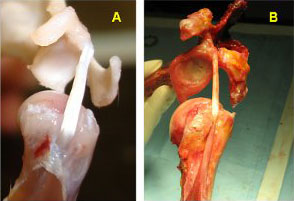Role of Altered Loading in Pathological Changes in the Long Head of the Biceps Tendon Following Rotator Cuff Tear
Damage to the long head of the biceps tendon is common clinically and has often been identified as a source of shoulder pain. Further, damage to the biceps tendon is frequently seen in the presence of rotator cuff tears. However, there is some debate over the role of the biceps tendon at the shoulder following a rotator cuff tear. Some believe the biceps plays a significant role as a humeral head depressor while others believe the biceps plays no role at the shoulder at all. Therefore, controversy exists regarding the optimal treatment for the damaged biceps tendon, with physicians relying mostly on anecdotal experience. Unfortunately, most clinical studies are not able to address the underlying cause of biceps tendon changes in the presence of rotator cuff tears in a controlled manner and cadaveric studies cannot monitor the injury process with time. Tendon degeneration and inflammation are both thought to play a role in this damage; however, the mechanisms which lead to biceps changes remain unknown which makes clinical management of this problem difficult. Determining the origin of pathology in location and type of change would help to identify the extrinsic mechanism by which these changes occur as well as the initiating biologic events that lead to tendon degeneration in this scenario.

Therefore, the overall objective of this study is to examine the effect of alterations in mechanical loading on the initiation of pathological changes in the long head of the biceps tendon following rotator cuff tears in order to determine its role as a mechanism for these changes. To accomplish this objective, we will use an animal model of biceps tendon pathology in the presence of rotator cuff tears, both alone and in combination with additional changes in joint loading, to investigate the cause and effect relationships between changes in mechanical, histological and organizational properties along the length of the tendon. Our global hypothesis is that rotator cuff tears result in altered joint loading conditions that lead to degeneration of the long head of the biceps tendon, beginning at the insertion site and continuing along the tendon length with time.
For more information see:
- Peltz CD, Perry SM, Getz CL, Soslowsky LJ. Mechanical properties of the long-head of the biceps tendon are altered in the presence of rotator cuff tears in a rat model. J Orthop Res. 27(3):416-420, 2008.
